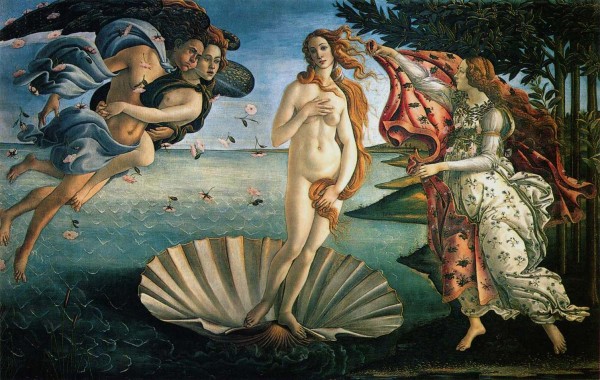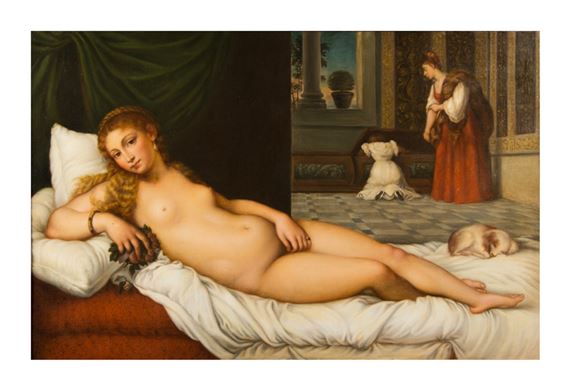
Challenging the long tradition of feminine nudes in art, dating back to ancient Greece, Manet caused quite a stir when he unveiled Olympia (1863).
Manet reached back centuries into the past with Olympia and gave a resoundingly modern twist to the tradition of the nude, particularly depictions of venus from the renaissance and neo-classical eras.
Manet saw the repeated motifs in these paintings, the models often seemed coy, not making direct eye contact, shyly covering parts of their bodies. You don’t need to go much further than Sandro Botticelli’s Birth of venus for an example of this:

There is definitely something sensual in these works, but nothing as deliberate as Olympia. Manet delighted in observing social moral codes, particularly the ones that set Parisians on edge.
He took inspiration from Titan’s 1534 painting “Venus of Urbino” (below) but stripped away the veil of mythology. Manet didn’t want the people viewing the piece to see a goddess, but a woman.
Olympia, a common name used by Parisian prostitutes at the time, was a recognized courtesan in Paris. She’s seen in the painting, lounging on her bed greeting you, yes you, her next client.
In 1865, Manet submitted his risqué painting to the French Salon. They accepted the painting despite their disapproval of the subject matter and a scandal was born. Olympia had to be hung very high to protect it from physical attacks.
Victor de Jankovitz wrote that “the expression of [Olympia’s] face is that of a being prematurely aged and vicious; the body’s putrefying color recalls the horror of the morgue.” The critic Geronte called Olympia “that Hottentot Venus with a black cat, exposed completely naked on her bed like a corpse on the counters of the morgue, this Olympia from the rue Mouffetard [a notorious haunt of prostitution at the time], died of yellow fever and already arrived at an advanced state of decomposition.” The piece was often satirized in the Parisian newspapers:
Fair to say, Olympia wasn’t an immediate hit.
Desafiando la larga tradición de los desnudos femeninos en el arte, que se remonta a la antigua Grecia, Manet causó un gran revuelo cuando presentó Olimpia (1863).
Con Olimpia, Manet se remonta a siglos atrás y da un giro rotundamente moderno a la tradición del desnudo, especialmente a las representaciones de Venus de las épocas renacentista y neoclásica.
Manet vio los motivos que se repetían en estas pinturas, las modelos a menudo parecían tímidas, sin hacer contacto visual directo, cubriendo tímidamente partes de su cuerpo. No hace falta ir mucho más allá del Nacimiento de Venus de Sandro Botticelli para encontrar un ejemplo de esto:
Sin duda hay algo sensual en estas obras, pero nada tan deliberado como Olympia. A Manet le encantaba poner en vilo a los parisinos.
Se inspiró en el cuadro de 1534 de Titán “Venus de Urbino” (abajo), pero despojado del velo de la mitología. Manet no quería que los espectadores vieran una diosa, sino una mujer.
Olimpia, nombre habitual de las prostitutas parisinas de la época, era una cortesana reconocida en París. Se la ve en el cuadro, tumbada en su cama saludando, sí, a usted, su próximo cliente.
En 1865, Manet presentó su arriesgado cuadro al Salón Francés. Aceptaron el cuadro a pesar de su desaprobación del tema y nació un escándalo. Olympia tuvo que ser colgado muy alto para protegerlo de las agresiones físicas.
Victor de Jankovitz escribió que “la expresión del rostro [de Olympia] es la de un ser prematuramente envejecido y vicioso; el color putrefacto del cuerpo recuerda el horror de la morgue”. El crítico Geronte llamó a Olimpia “esa Venus hotentote con un gato negro, expuesta completamente desnuda en su cama como un cadáver en los mostradores de la morgue, esta Olimpia de la rue Mouffetard [un notorio lugar de prostitución de la época], muerta de fiebre amarilla y ya en avanzado estado de descomposición”.
Hay que decir que Olympia no fue un éxito inmediato.
